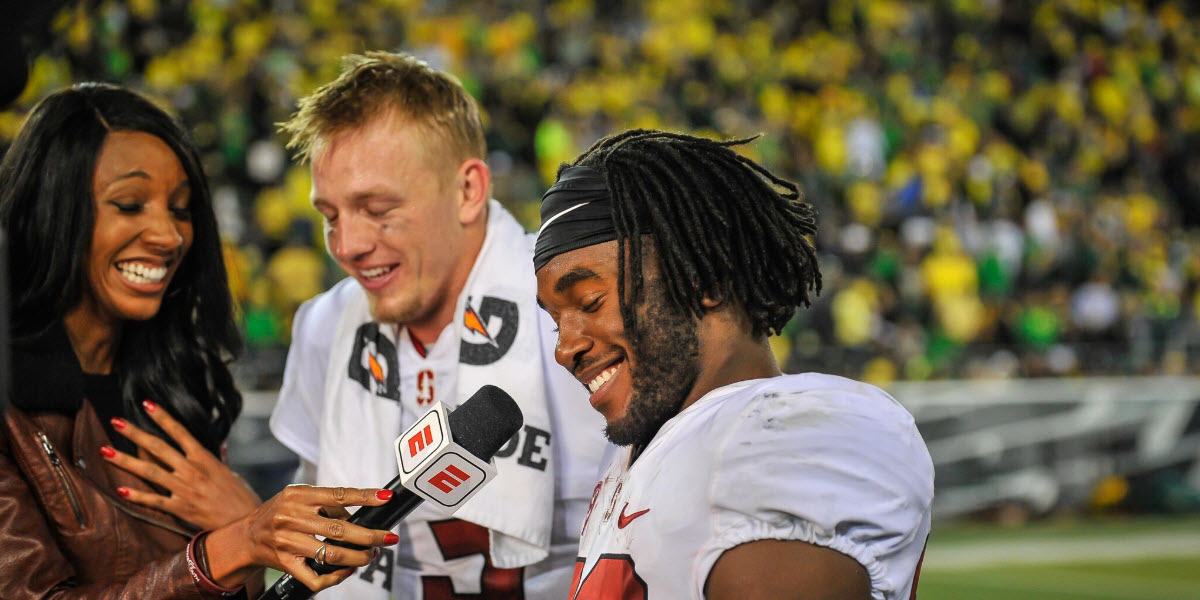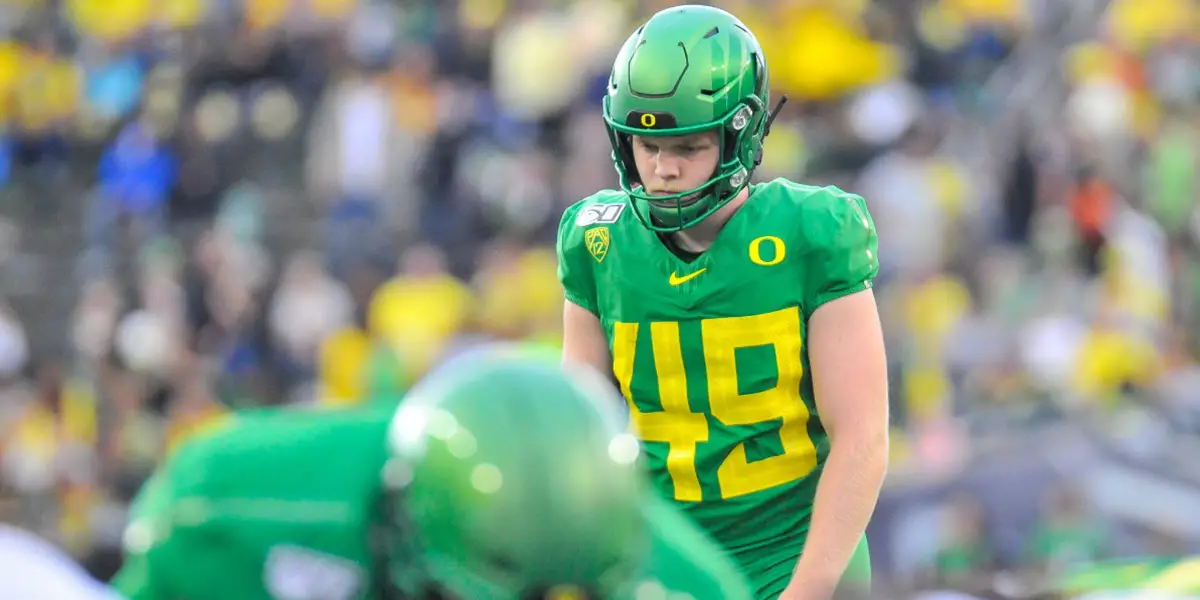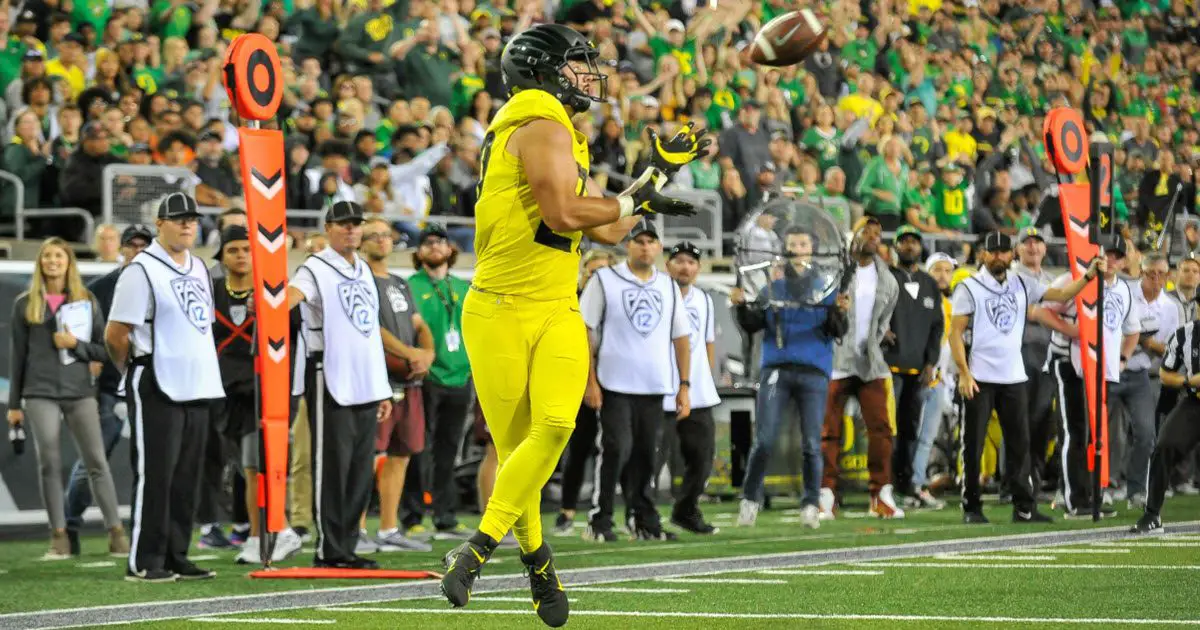Oregon’s Justin Herbert continued to pad his passing resume with an impressive 30-of-42 attempts for 316 yards and five touchdowns and the Ducks did as expected, dominating Montana 35-3. Herbert’s first scoring toss was an NCAA record 31st straight game with a touchdown pass, although his longest completion was only 21 yards.
The Duck offensive line afforded Herbert solid pass protection, although he did have to scramble several times to avoid a stubborn Montana rush. He was able to gain 18 yards on two rushes and showed the speed and elusiveness that coach Mario Cristobal might consider including in his running game package.
The defense allowed just eight yards rushing, or 0.4 yards per carry, with the longest run allowing only five yards. The Grizzlies showed no panic or “give up,” and faced the Ducks chin to bill; the only problem was that the Ducks’ bill was bigger and stronger than their opponent’s snout.
Above is an example of a problem Oregon’s passing game has suffered the past two years: the Ducks need six yards for a first down, but throw a short pass to a receiver who is not at first-down yardage. In this case, a scrambling Herbert hits running back Travis Dye with a throw that gains only four yards, forcing a punt.
The tight end is running toward the outside, one yard short of the first down, and the split receiver on the right ran through an open window where Herbert might have thrown the ball.
Herbert (above) completes a pass to freshman wide receiver Josh Delgado for an 18-yard gain, one of three receptions he had for 35 yards. The quarterback fakes a handoff and drops back behind perfect pass protection against a blitz, which is five or more rushers; in this case it’s five. The Duck offensive linemen have good pad levels and have effectively jammed the Montana pass rushers into a wad.
The receivers on the left side of the formation drive their defenders deep enough that Delgado can run a drag route across the formation where Herbert finds him all alone.
Duck quarterbacks completed 30-of-42 pass attempts for 313 yards, with 12 different receivers catching balls. Five wide receivers, three tight ends and four running backs caught passes, presenting an intriguing balance to Oregon’s suddenly dangerous pass offense.
In this example (above), running back CJ Verdell (No. 7) catches a quick, short pass (almost a lateral) and with his quickness and running ability, turns it into a 21-yard gain. It is a high percentage pass and is the equivalent of an “end run” that gets the ball outside the pocket quickly and into open.
Note the athletic left tackle, Calvin Throckmorton (No. 54) pulling to provide a personal escort for Verdell, along with the aggressive blocking of receivers downfield. It is a strength of the offensive line that there are athletes who can pull and block effectively in the open field. Verdell is an excellent open field receiver in addition to his slashing inside running ability.
This is rare footage for a Mario Cristobal offensive play call: fourth-and-short (above) and the Ducks eschewing their traditional A Gap Plunge and throwing a play action pass off that run action.
After two years of running the ball inside on fourth-and-short with sketchy results, the worst possible thing happens — the tight end, Ryan Bay (No. 87), drops the ball. The film shows the zealous reaction of the front eight defenders to the run fake, which opens up the area for the left tight end, who delays his release selling the run and then crosses the middle totally uncovered to catch an easy throw (slightly behind) from Herbert — except he doesn’t.
Although not a big play in this football game, it clearly shows defensive coaches what the Ducks can do if they want to — take advantage of their heavy tendency to rely on the line plunge on fourth-and-short to open up easy lanes for a play action pass.
One can only hope that the dropped pass does not traumatize Cristobal from trusting the play action pass in future situations. It will still be there, either for a tight end, or a wide receiver going one-on-one with a defensive back and half the field to work with.
The Grizzlies had an excellent game plan to try to control the game clock and limit Oregon’s time on offense. To limit the potent Duck offense to only 35 points was an accomplishment for a team that was outweighed on both the offensive and defensive line and was a heavy underdog.
Here, Montana (above) goes to razzle-dazzle: a short pass on a quick screen from Dalton Sneed to wide receiver Louie McGee for a loss of three yards, but before he is tackled to the ground, laterals to running back Marcus Knight (No. 21), who runs for 11 yards to the Duck seven-yard line. The alumni always love a play like this.
Oregon’s defense shows excellent hustle, as they did all game, but future opponents’ offensive coaches will note that with this pursuit, the defense may be susceptible to a reverse. It is imperative that the backside pursuit keeps their eyes on the ball and maintains their leveraged positions to prevent a reverse; difficult to do when you are running full speed at what you think you see.

Stanford was pretty happy with their victory last year.
Oregon travels to Stanford to try to break a three-game losing streak to the Cardinal. Everyone remembers the heartbreak of last year’s collapse that resulted in a Stanford win in overtime. The Ducks had a huge lead, disappeared on offense and gave up two horrendous turnovers in the second half that gave the Cardinal a chance to win a game in which they were outplayed.
After three games, it appears that Cristobal has grown more comfortable moving the ball up and down the field with Herbert’s great leadership and throwing skills. Instead of a mess of two and three-yard line plunges, the Ducks appear to have a balanced pass offense, but it wasn’t so in the opener against Auburn and it might not be against a proud Stanford defense that has been beaten up in their last two games.
The only weakness Cristobal has to worry about going to Palo Alto is that he can’t say he has an accomplished field goal kicker, at least by game performance this season. Freshman Camden Lewis is that man, and his head coach chose to ignore an opportunity for a field goal attempt, and valuable experience, against Montana, saying it “…felt we needed to keep playing football.”

Camden Lewis (No. 49) will need to be clutch for the Ducks…
Last time I checked, “football” includes kicking field goals, and one can look back to 2011 and 2012 when the Ducks’ failure to develop a strong field goal kicker led to defeats that came in the last seconds of the USC game and in overtime, against Stanford, at home. Although the Ducks went on to a Rose Bowl win in 2012 (2011 season) and a Fiesta Bowl win in 2013 (2012 season), the losses kept Oregon from going to the National Championship Game each year.
In the Stanford defeat, Chip Kelly went for a touchdown on fourth-and-four in the first quarter instead of a field goal; three points would have meant victory in the end. As it was, the Ducks’ kicker missed a 41-yard attempt in overtime to give the Cardinal the victory.
Last season, Stanford’s kicker calmly booted a 32-yard field goal as the gun went off to send the game into overtime, where the Cardinal put the Ducks away for the third straight year. It’s good to have a strong field goal kicker. It’s still a mystery to what kind of kicker the Ducks have this season.
Coach Ken Woody
Eugene, Oregon Top Photo by Kevin Cline
Want to learn from Coach Woody in person? He will be analyzing the prior game each week this season at the 6th Street Grill in Eugene on Wednesdays from 6:00 to 7:30 PM with video analysis and opening it up for questions. Join him and learn more football! Charles Fischer

Natalie Liebhaber, the FishDuck.com Volunteer Editor for this article, works in the financial technology industry in Bozeman, Montana.
Dan Fouts, NFL Hall of Fame, Oregon Ducks quarterback: “Entertaining and easy to understand.”
“Every Oregon fan should have a copy to learn from as I do.” Charles Fischer
Buy the book here to learn from Coach Woody, or give a gift of football, a great gift for the fan who wants to learn and enjoy more of the Duck (or whoever your favorite team is) football experience.
Ken Woody is a former Fox Sports football commentator who played defensive back, receiver and kicker for Oregon from 1966 to 1970. He coached college football for 18 years, including stints as an assistant coach at Oregon, Washington, Washington State and Utah State, and was head coach at Whitman College and Washington University-St. Louis. He writes x’s and o’s, a weekly column in the Register-Guard, RG online coverage of Duck football and is the author of “After Further Review—an inside look at what’s really happening on the football field.” Woody is on KUGN (590 am) 2:45 before kickoff and 30 minutes after each game with coaching and game analysis.
Related Articles:
“I learned football working under many great coaches, among them Len Casanova, Jerry Frei, John Robinson, Bruce Snyder, George Seifert,and Ron Stratten at the University of Oregon, Jim Owens at the University of Washington and Jim Walden at Washington State University. Most of my coaching experience was on the offensive side of the ball with quarterbacks, receivers and kickers although as a head coach I coached defensive backs, linebackers and offensive line.
I achieved my first goal of being the youngest head coach in college football at the age of 26 and throughout my career in coaching and outside of it, as a journalist and broadcaster, have experienced how exciting and gratifying it is teaching the game to others.”


